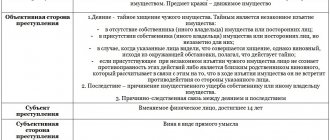A report on the discovery of signs of a crime is a special type of legal document, the main purpose of which is to inform the head of a law enforcement agency about the information discovered in a particular case.
The report sets out circumstances and facts that may subsequently become the basis for initiating a criminal case. The rules for drawing up and conditions for drawing up a report on finding signs of a crime are set out in the new edition of Article 143 of the Code of Criminal Procedure of the Russian Federation dated February 19, 2018. Multi-channel free hotline Legal advice on criminal law. Every day from 9.00 to 21.00
Moscow and region: +7 (495) 662-44-36
St. Petersburg: +7 (812) 449-43-40
Report form on detection of signs of a crime
The correct sample of a report on finding signs of a crime can be found in the appendix to the Criminal Procedure Code of the Russian Federation (Code of Criminal Procedure of the Russian Federation). However, there are no particularly strict requirements for the report form. This means that the report can be written in free form.
However, there are a number of parameters that must be specified in this type of document:
- Place of occurrence.
- Time of commission of the offense.
- The essence of the crime (what happened and under what circumstances).
- Information about suspects and witnesses of a crime.
In the upper right corner you must indicate the title and position of the manager for whom this document is being drawn up.
At the bottom of the document, the title and position of the employee who draws up this report must be indicated, his signature must be placed, and the date of drawing up the report must also be indicated. It is not necessary to indicate the date, because immediately after the document is received, the duty officer registers the report in the book for recording crime reports.
As a rule, at the end of the report, the law enforcement officer will conduct an inspection and investigation of the incident in the manner prescribed by law.
After registering a report, it is submitted to the head of the relevant law enforcement agency, who has the authority to begin an inspection and investigation. Often, the head of the service gives instructions regarding the investigation to the very employee who drew up the report, allowing him to continue to deal with the matter.
However, not all cases of reporting result in criminal prosecution.
As a result of checking the incident, the head of the investigative body can make one of the following three decisions:
- he can initiate criminal proceedings;
- he may refuse to initiate proceedings;
- finally, in certain cases he may transfer the case to jurisdiction.
Thus, a report on finding signs of a crime performs two important functions: with its help, the employee informs the head of the service about the incident and the circumstances surrounding it, and also asks for his permission to continue the investigation in this case. But the employee may be denied the latter.
Reasons for drawing up a report
A report on the discovery of signs of a crime can be written not only based on the results of the work of an employee of the investigative agency.
Any citizen of a country or republic has the right to report or report an offense. After all, the main task of the law enforcement system is to protect and protect the interests, rights and lives of citizens of the state, including from any criminal acts and attacks by other persons. Thus, a report can be drawn up by a service employee at the request of any citizen of the Russian Federation. Source of information, i.e. information about the citizen who reported the crime committed is necessarily recorded.
A report on finding signs of a crime is a document necessary in criminal procedural law for a competent and legal investigation of the circumstances of the offense. This document is drawn up before the start of criminal proceedings and can become the basis for its initiation.
In the current version of Art. 143 of the Code of Criminal Procedure of the Russian Federation sets out the principles for drawing up and submitting a report on an offense:
- A report can be drawn up only after notification of an impending or committed offense.
- The report can only set out the objective side of the offense, which can be classified as a dangerous, especially dangerous or socially dangerous act.
- All available evidence is analyzed, witnesses in the case are questioned, and only on the basis of the available information a report is drawn up.
- The mere fact of a report of a crime cannot become a basis for initiating criminal prosecution.
Speaking about the last point, it is worth noting that there are cases when, for example, the information in the report submitted to the head of the service has nothing to do with the offense, since there are completely no signs of a crime in the case.
In this case, we cannot talk about the need to initiate a criminal case. In addition to citizens’ statements about the commission of a crime, there are a number of other grounds for which an act is detected and a report is drawn up:
- when the employee became aware of the commission of a crime;
- after receiving an oral message about the commission of a crime (including a telephone call);
- as a result of operational search activities;
- as a result of detection of reports in the media and other publications about the commission of an offense;
- as a result of the discovery of another offense during the criminal process.
Law enforcement officials can learn about the commission of an offense from any source, including citizens and the media.
Features of document preparation
The procedure for drawing up a report on the detection of signs of a crime is regulated by Art. 143 of the Code of Criminal Procedure of the Russian Federation.
According to its contents, the document consists of:
- law enforcement officers;
- employees of operational investigative units;
- employees of the bodies of inquiry, prosecutor's office and preliminary investigation.
Drawing up official documentation of this type is the responsibility not only of employees authorized to initiate criminal cases, but also of other employees of the Ministry of Internal Affairs who witnessed a violation of the law. Regardless of time, position, location on the territory of the Russian Federation, every police officer is obliged to take measures to suppress the crime and report to the nearest police unit as soon as possible.
Many people confuse a report with a statement. Unlike a statement, the report does not contain demands to prosecute and punish the perpetrator. The document shows only the circumstances of the incident and the persons involved. It should also be noted that the report is drawn up on the basis of a message about the commission of a crime, and does not lay out the essence of the message in the report.
Article 143 of the Code of Criminal Procedure of the Russian Federation states that a report can be evidence in a case, but only if it is certified by the signature of a law enforcement officer and contains comprehensive information about the signs of a violation, as well as the source of the information received. Without identifying a specific source, a police officer's written report will not be admissible evidence.
The exception is information about the source, which contains state secrets; such data cannot be fully indicated in the report. In this case, a written denunciation serves as a reason for starting criminal proceedings, but is not evidence in the case.
The procedure for filing a statement of crime under the Code of Criminal Procedure of the Russian Federation, Article 141
In Art. 143 of the Code of Criminal Procedure of the Russian Federation with comments from the current edition sets out the principles of drawing up and submitting a report on the commission of a crime:
- The document can be drawn up after a report of an impending or committed crime. There is an exception to this point - sometimes, a report can be filed by an employee participating in operational-search activities who has determined the fact of preparation for a crime. In order to prevent a serious violation of the law, criminal proceedings may be initiated, for example, if the message contains the fact of preparation for a terrorist act.
- The denunciation sets out exclusively the objective side of the crime.
- Initially, it is necessary to verify the reliability of the information by interviewing witnesses, analyzing evidence, and only after that, if there is sufficient data, draw up a report on the incident.
- The mere fact of reporting a crime is not grounds for initiating proceedings. There are cases when the report on the crime committed contains no signs of violation and it is impossible to initiate a case.
If a police officer himself has become an eyewitness to a criminal act, he cannot conduct an investigation into the case, but is subject to recusal. The fact is that there is a need to interrogate him as a witness. The same applies if the police officer who reported the crime is an interested party. He cannot state his demands in the report.
That is why, in addition to reporting the incident, he must submit a written statement about the incident with demands to bring the offender to justice. Initially, a report is recorded, and then a statement. From the moment the application is registered, the employee who filed the report will appear in the case as a victim.
Report on citizens' reports
In total, there are two sources of obtaining information about atrocities, when committed, a report is drawn up on finding signs of a crime:
- Information can be obtained from any citizen of the country orally or in writing.
- Information may become known to law enforcement services as a result of its publication in the media, the Internet, etc.
A message about a committed or planned crime can be transmitted by a citizen orally or in writing. For example, a person who has information about someone being kidnapped or held hostage can report this to a police officer. The employee, in turn, is obliged to report this information to his management by writing an appropriate report. It can also be compiled even on the basis of a telephone call made to the all-Russian number 02.
If a crime was detected by a law enforcement officer, and the citizen refrained from filing a statement about the offense committed, this officer is also obliged to draw up a report and send it to the leadership of the internal affairs department.
In the case when a person refuses to report the act committed, the report is still drawn up in accordance with the requirements of the Code of Criminal Procedure of the Russian Federation. Intentional concealment of actions of a criminal nature is a violation of the law, and therefore the citizen bears criminal liability. This is due to the fact that many offenses are potentially dangerous both for residents of the city and country, and for the state as a whole, even despite the fact that a crime can be committed against an individual.
There are also public matters that do not require a statement from an individual or group of individuals to identify them. A report drawn up by a law enforcement officer, which contains all the necessary information, is the basis for initiating a case.
All types of crimes, the commission of which requires a statement from the victim, are classified as private cases. Their list is determined by Article 20 of the Code of Criminal Procedure of the Russian Federation.
Comments to Art. 141 Code of Criminal Procedure
Article 141 of the Code of Criminal Procedure is of great importance, so there are many comments on it.
The main ones are:
- The form and content of the application must comply with the requirements listed in Article 84 of this Code (evidence in the form of a document) or Art. 83 and 166 (rules for drawing up the protocol). A statement may be the basis for initiating a case if it includes information about signs of an unlawful act or a request to prosecute a specific person. If the document does not contain data on the signs of a crime, it can still become a reason to initiate a case. An employee of the Ministry of Internal Affairs is obliged to accept the application and conduct an investigation; perhaps signs of an illegal act will be obtained from other sources.
- If we are talking about a private or private-public accusation, then only the victim or his legal representative can act as an applicant. The application is submitted to the court office, and the number of copies of the document must correspond to the number of accused. In cases of private prosecution, the statement replaces the indictment of the investigator.
- Regardless of jurisdiction and jurisdiction, a written or oral statement must be accepted by any employee of the Ministry of Internal Affairs or a judge.
An application is considered anonymous if it does not contain the signature of the author and there is no information about him. The anonymity of the author is the reason that the statement does not acquire legal force. An anonymous statement cannot become a reason to initiate a case.
Such statements are not registered and are not considered in accordance with the established criminal procedure. If an anonymous message contains information about an act that poses a danger to society, then it becomes a reason for an inspection. If its result is the identification of signs of a crime, then a criminal case is initiated in the manner established by Article 143 of this code.
An anonymous statement can become material evidence in the future. For example, if law enforcement agencies received a written statement about an impending terrorist attack, but the information was false, then the document can be used to prove the guilt of a perjured person in accordance with Articles 306 and 207 of the Criminal Code of the Russian Federation. If an anonymous message has signs of future material evidence, then the person receiving it should take measures aimed at preserving traces, for example, fingerprints on paper.
The applicant's rights are listed in Article 144 Part 4 and Article 145 Part 2 of the Code of Criminal Procedure
Reporting an offense initiated by government services
A report on finding signs of a crime can only be drawn up by a competent and authorized law enforcement officer.
The document is drawn up based on the testimony of citizens or information received from the media. It can also be issued based on the results of the employee’s actions, thanks to which the authorities were able to detect the crime. This document allows you to generate reports and statistics on all crimes committed. The report is issued in any of the following cases:
- upon discovery of the death of a victim who was killed;
- upon detection of crimes against the state and public services;
- upon discovery of other consequences of a crime committed secretly, etc.
In all these cases, applications from citizens are not required. A report drawn up by a law enforcement officer is the basis for initiating prosecution. In this case, an indicator of the high level of work of a police officer is the fact that he uncovered the crime he committed.
A report drawn up based on the results of operational activities
A report can be filed by a law enforcement officer not only after the crime has been committed, but also before.
If, as a result of the investigation, an authorized officer learns of an impending crime, he can draw up a report in order to prevent the commission of a crime. However, this tactic is not very productive. After conducting operational-search activities, it will be impossible to initiate a case due to lack of evidence. Therefore, the best option would be to expose the offenders during the commission of a crime, which will subsequently make it possible to bring them to criminal responsibility. Such crimes include various types of criminal acts, including:
- Crimes related to drug trafficking.
- Thefts and robberies.
- Socially dangerous acts, as a result of which other structures for the protection of citizens and law and order are involved (Ministry of Emergency Situations, Ministry of Internal Affairs, etc.).
- Cases investigated within the framework of the Code of Civil Procedure of the Russian Federation.
- Crimes against government agencies.
As a rule, such cases are not recorded in the crime reporting book. They are recorded in special documents that are strictly classified and not subject to public disclosure.
In operational accounting, information is recorded by operational services in order to further improve operational developments.
After the arrest of offenders, an ordinary report is drawn up in accordance with all the requirements of the Code of Criminal Procedure of the Russian Federation, which is subject to registration and transfer to the head of the law enforcement service.
The report and the information contained in it are checked within 10 days. In special cases, the inspection time may be extended for a period of no more than 30 days. However, in some particularly serious cases, when identification of particularly dangerous crimes is required, several months are needed.
The implementation of operational activities begins from the moment public verification actions begin and a case is initiated. Before filing a report, evidence and evidence are collected, suspects are detained, and the necessary documents are filled out.
Report on a crime identified during the investigation
Filling out and submitting to the manager a report on the commission of a crime is mandatory even if the crime was discovered during the investigation of another case.
During the course of their investigation, an agency employee may reveal the fact of a crime committed or a crime being prepared. Often it has nothing to do with the case during the investigation of which the offense was discovered. However, practice shows that sometimes the identified crime and its circumstances can be very closely related to the original criminal case. It is important to note that a statement about a committed or impending crime can be submitted orally during a court hearing by either party. In this case, this information is recorded in the protocol, a copy is notarized and sent to law enforcement agencies in the form of a report. This information can significantly change the course of the trial.
Such a report has the same form as a report on the detection of signs of a crime. It must indicate:
- rank, position and full name of the manager to whom the report will be addressed;
- information about the crime committed, indicating the time, place, participants and witnesses of the crime;
- information about the employee who compiled the report (position, rank, full name);
- date of compilation;
- signature of the report writer.
A check based on the results of a registered report is carried out in the same form as a check when working with an ordinary report. In addition, the initiation of a criminal case may also be refused.
Upon completion of the inspection report, the parties to the criminal investigation and other interested parties must be notified of the results of this inspection and the decision of management. In addition, they are explained all their rights related to appealing the decision.
A report on the discovery of signs of a crime is an integral part of the criminal process. Compiled on the basis of information received by the employee from citizens of the country or from other sources, including the media and the Internet, the report is often the basis for initiating a criminal case. In addition, detailed and brief information about the parties to the crime, evidence, the place and time of its commission and witnesses allows you to quickly understand the essence of the case and carry out the necessary investigative measures.
Article 141. Statement of a crime
Published 02/03/2011
1. A statement about a crime can be made orally or in writing.
2. The written statement of the crime must be signed by the applicant.
3. An oral statement about a crime is entered into the protocol, which is signed by the applicant and the person who accepted this statement. The protocol must contain information about the applicant, as well as documents identifying the applicant.
4. If an oral report of a crime is made during an investigative action or during a trial, then it is entered, respectively, in the protocol of the investigative action or the protocol of the court session.
5. In the event that the applicant cannot be personally present when the protocol is drawn up, his application is drawn up in the manner established by Article 143 of this Code.
6. The applicant is warned of criminal liability for knowingly false denunciation in accordance with Article 306 of the Criminal Code of the Russian Federation, about which a note is made in the protocol, which is certified by the signature of the applicant.
7. An anonymous statement about a crime cannot serve as a reason to initiate a criminal case.
Commentary on Article 141
1. Statement of a crime - a document that sets out the events and circumstances assessed by the applicant as a crime committed or being prepared.
2. A statement about a crime can be made orally or in writing. Oral statements are understood as appeals from citizens and organizations to law enforcement agencies or to a judge without them transmitting in writing information about a crime committed or being prepared. An oral statement about a crime is entered into the protocol, which is signed by the applicant and the person who accepted the statement. The protocol must contain information about the applicant, as well as documents identifying the applicant. If an oral report of a crime is made during an investigative action or during a trial, it is entered, respectively, in the protocol of the investigative action or the protocol of the court session.
3. When accepting an oral application, a law enforcement officer must properly determine the identity of the applicant using a passport or other identification document. In the event that the applicant cannot be personally present when the protocol is drawn up, his application is formalized as a report on the discovery of the crime.
4. The applicant is warned of criminal liability for knowingly false denunciation in accordance with Art. 306 of the Criminal Code, about which a note is made in the protocol, which is certified by the signature of the applicant. In the case where the applicant has not reached the age of sixteen, he should be explained in a form understandable to him the criminal procedural consequences that arise from the statement he submits about the crime committed. Such applicants are not warned of criminal liability for knowingly false denunciation. However, it is advisable to make a note in the protocol of the oral statement, certified by his signature, about explaining to the minor or minor the consequences in connection with his filing of an application.
5. The written statement of the crime must be signed by the applicant. In this case, the applicant must also be warned of liability under Art. 306 of the Criminal Code, if he personally arrived at a law enforcement agency in order to hand over a statement he had written. If the application is received by mail, then a warning about liability is issued either upon receipt of explanations from the applicant, or upon interrogation of him as a victim or witness.
6. In cases where the written statement is written indistinctly and the information contained in it is difficult to evaluate, it is advisable to recommend that the applicant fill out his statement according to the rules for accepting an oral statement and, if he agrees, draw up a protocol of the oral statement about the crime committed in compliance with the requirements provided for in the commentary. article.
7. Messages about a crime committed or being prepared, coming from institutions, organizations and enterprises, as well as from officials, must be made in writing and contain the details of an official document.
8. An anonymous statement about a crime cannot serve as a basis for initiating a criminal case. At the same time, the investigative body should not ignore anonymous information indicating the criminal nature of the event. Anonymous letters containing information about a crime are not destroyed, but are transferred to operational services for use in suppressing and solving a crime.









